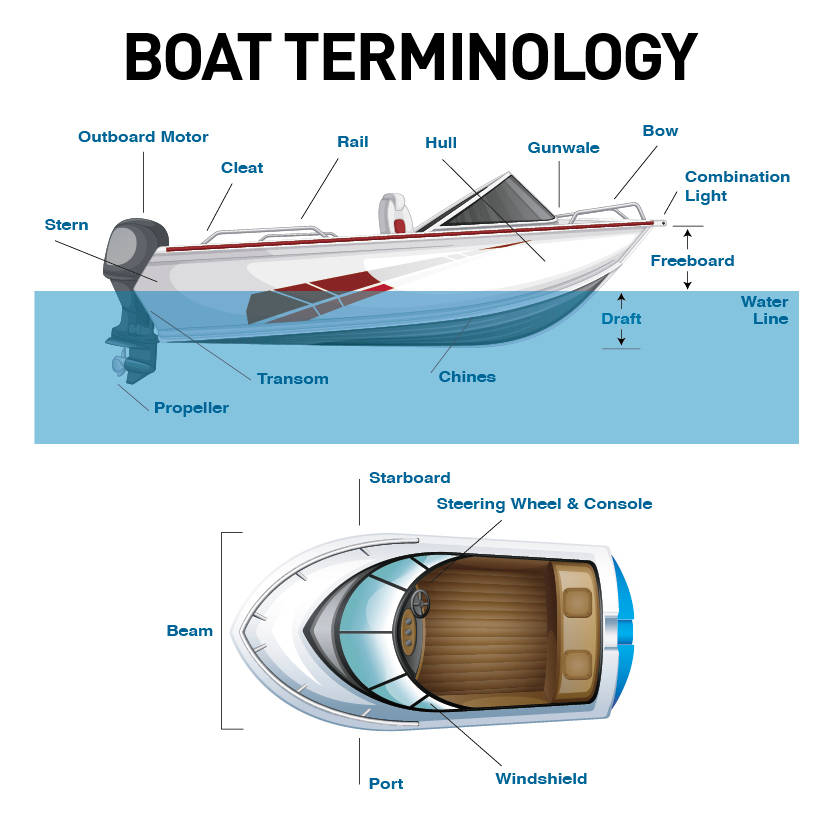
Parts of a Boat from Bow to Stern & Everything in Between
Share article
If you are new to boating, you’ve probably figured out that there is a whole new vocabulary associated with owning a boat.
We want to make it easy and teach you the basic parts of a boat, complete with a detailed description of each component, how they work and why they are important.
What are the parts of a boat called?
We’ve created a list of boat parts and what they are called. We include a definition of the boat parts, why they are important, and where they are located on the boat.
1. What is a beam of a boat?
The boat beam is the overall width of a boat measured at the widest portion of the waterline.
The beam section of a boat is important for two reasons:
1. The beam size determines if passage around an obstacle in the water can be done safely.
2. The beam also determines the boat’s overall stability.


4. What is the cleat on a boat?
Cleats are especially important to docking and tying up your boat. They are used to tie ropes through when you are securing your boat to a dock or slip. They are securely affixed to your ship in various places on your boat that offer the best functionality when docking.


5. What are combination lights on a boat?
The combination lights on a boat, also known as sidelights, are red and green lights visible to other boats approaching either head-on or on the side.
The red light indicates the boat’s port (left) side, and the green reflects the vessel’s starboard (right) side.


7. What is the freeboard of a boat?
A boat’s freeboard is the distance from the waterline to the upper deck level where water can enter the boat or ship, also known as the lowest point of sheer.
This measurement, or freeboard, is typically higher on offshore and console boats than skiffs or bay boats. The higher the freeboard, the more protected the boat is from being washed out.


10. What is starboard and port, and why are they called that?
Starboard is on the right side of the boat when looking toward the bow, and port is the left side of the boat.
Before ships had rudders on their centerlines, they were controlled by a steering oar. Sailors called the right side the steering side, which became starboard, the combination of the Old English words, stéor meaning "steer" and bord meaning "the side of a boat."
Port came about because as boat sizes got bigger, so did the steering oar. This size increase made it much easier to tie up a boat to a dock on the left side of the oar, known as the larboard, the "loading side." Larboard was too similar to starboard, so it was changed to port, as this was the side that faced the port when entering the dock and allowed the ship's supplies to be ported aboard.


11. What is a prop on a boat?
The motor powers boat propellers. They typically have three to five blades that turn on a shaft - and the more blades, the higher propulsion.
Boat propellers include blades that turn on a shaft powered by the motor. Propellers can have three, four or five blades. Typically, the more blades on the propeller, the more propulsion can be achieved. While the motor provides the power, the propeller is where all the action occurs. Propeller blades displace water to create the forces that move a boat forward.


13. What is the steering wheel and console of a boat?
The boat’s steering wheel is also known as the boat’s wheel. It is part of the steering mechanics at the boat’s helm, and as you would imagine, steers the boat. The wheel changes the direction of the boat’s rudder or tiller as the boat goes through the water.
The console is where the controls are located, including steering, ignition, radio, and other electronic devices. Consoles may have a small area for storage.


17. What is the windshield of a Boat?
The boat windshield is a major part of a boat. It deflects water and wind and keeps all aboard from getting soaked. Some boats have windshields, while others have windscreens, usually made from Plexiglass.
Sailboats typically have portlights which are small windows on the side of the boat that let light into the cabin.


These photographs, recommendations, and approximations are intended for demonstration purposes only and do not reflect the specifications of any watercraft. Always consult the manufacturer’s Owner’s Manual.













